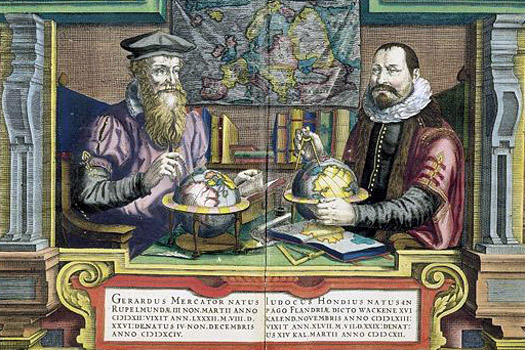
In Duisburg verfasste der Flame Mercator den ersten Atlas
Der universal gebildete flämische Kosmograf Gerhard Mercator und seine Nachfahren entwickelten in Duisburg wegweisende kartografische Produkte.
© Aus Atlasausgabe 1930
Kapital zurück zur Auswahl
Gerhard Mercator, a Flemish cartographer in Duisburg
An Astronomer of our time
There is a magnificent epitaph, created in the 17th century between the late Renaissance and early Baroque periods, located in the Duisburg Church of our Saviour. Anyone who views this memorial should not fear, according to the Latin inscription, “that this small clod of earth oppress the buried Mercator as a burden: The whole Earth is no burden for a man who felt her whole weight upon his shoulders and carried it as an atlas.“
In 1552, at age forty, Mercator, Flemish-born in Rupelmonde as Gheert de Cremer, settled in the Lower-Rhine town of Duisburg. Prior to this, he had earned a good name in Löwen as the “astronomer of our time” with his amazingly accurate maps and instruments. Arrested prior to the inquisition in 1544, accused of heresy (“Lutherey”), influential friends eventually secured his release.
In 1552, he moved to Duisburg on the Rhine with his family, his plans, and maps, where he hoped, in vain, to earn a chair at the University planned there. Nevertheless, the humanistic Mercator found recognition here as a scholar, something which he had been denied in Flanders. As a cosmographer, and philosopher, he attempted to paint a thorough picture of the world and its creation. He dedicated himself to this desire in his main work “Atlas”, posthumously published in 1595 containing 34 maps. Forgotten as a philosopher, Mercator, in Duisburg, coined the term “Atlas”; a word still today used to describe a bound collection of maps.
Prior to this he came up with a solution to the problem of trying to transfer the Earth’s round form onto a flat surface with the world map he designed in 1569: he decided on a conformal depiction of the Earth. For the first time the course of a ship could be depicted as a straight line-a vital prerequisite for the navigation of ships. The Mercator projection is still in use today, and is used, among other things, for GPS systems. Mercator died in 1594, his sons and grandson carried on his work. Since 1878, a fountain memorial in the castle square remembers the founder of the learned Duisburg “Duisburg doctum”.
Denkmale zum Impuls
Duisburg - Epitaph des Gerhard Mercator
Gerhard Mercator starb am 2. Dezember 1594 in Duisburg; in der evangelischen Salvatorkirche in ... weiter
Duisburg - Mercatorbrunnen
Im Jahr 1869 wurde in Duisburg bekannt, dass die belgische Stadt Rupelmonde als Geburtsstadt des ... weiter

